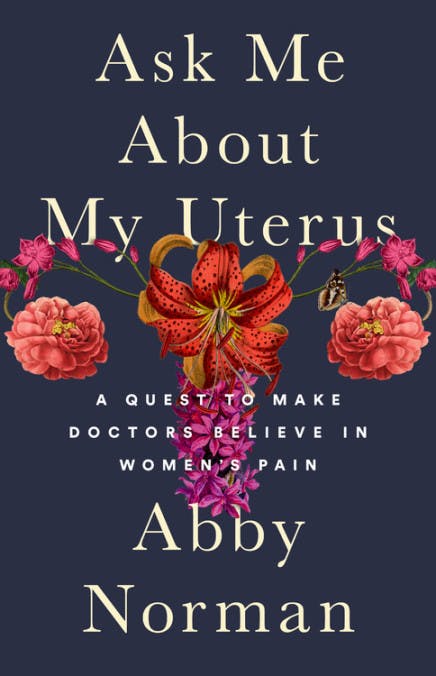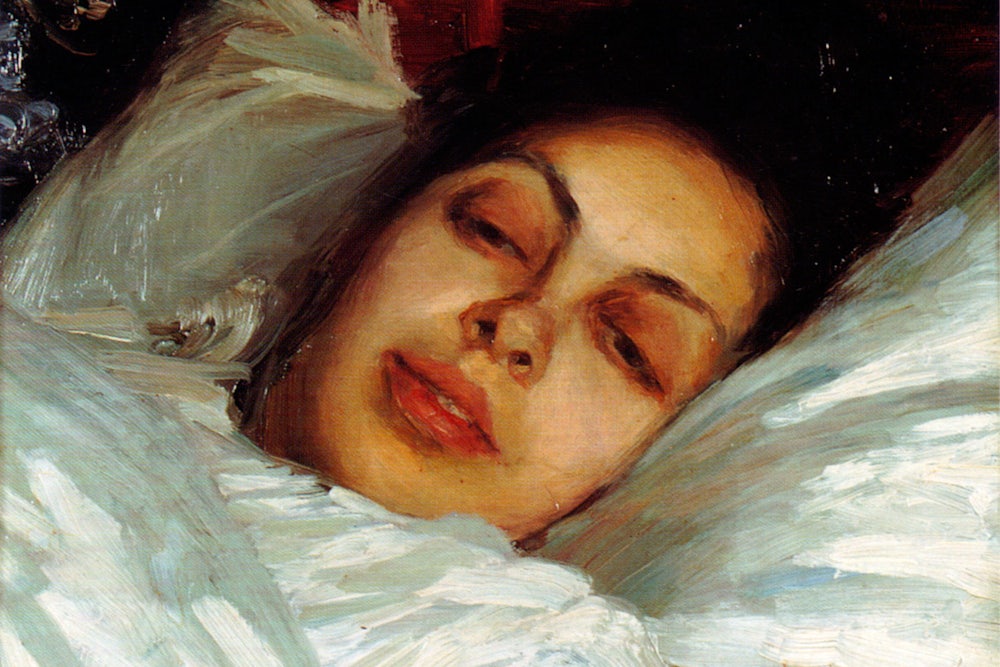To conceive of another person’s pain is to undertake an obscure endeavor, one that’s often muddled by vexation, strained analogies and, at the crux of it all, doubt. We test the limits of empathy, questioning whether we can grasp another person’s reality—we probably can’t—and whether the sufferer has accurately deciphered the ebbs and flows of their body. In The Body in Pain, Elaine Scarry parses this disconnect: “To have pain is to have certainty,” she writes, “to hear about pain is to have doubt.” But doubt, and the murky dialogue that surrounds it, is typically a best-case scenario, particularly if the sufferer is in possession of a uterus.

Too often, a woman’s pain is not merely met with doubt, but suspicion, both within the medical community and outside of it. Author and activist Abby Norman, has put decades of labor—including careful, independent medical study—into studying this phenomenon, as she describes in her book Ask Me About My Uterus, both a memoir and a trenchant manifesto. Born to a mother who suffered from severely disordered eating, Norman procured legal emancipation from her parents at the age of sixteen, after a childhood marred by neglect and severe hunger. Chronicling her agonizing efforts to be treated for endometriosis, Norman presents the harrowing realities of her youth and young adulthood—years punctuated by debilitating physical ailments, invasive medical testing, and bludgeoning surgeries that, for all manner of reasons, rarely brought relief, let alone cures—and describes how she became her own advocate within a system not disposed to take her seriously.
The story she tells is strikingly and distressingly Victorian—a parallel she emphasizes by interweaving her memoir with accounts of late nineteenth-century hysteria cases, including Sigmund Freud’s famous patient “Annie O.” Like Freud’s so-called hysterics, who were diminished as “nervous” or excessively emotional, Norman found that her attempts at seeking medical care were frequently derailed by accusations that whatever she felt—thumping abdominal pain, limb numbness—was imagined, perhaps the result of her precocity or “over-active” mind. “You’re clearly very intelligent. Very clever,” sneered one particularly condescending (male) doctor whom Norman confronted.
The implication was that Norman—along with all women, transgender people and non-binary persons—could not be trusted to accurately, or honestly, articulate physical distress. The distrust, however, runs deeper. For centuries, wild theories about female anatomy have simmered: Norman describes, for instance, the seventeenth-century theory that the uterus—long believed to be the root of every female malady—bounced around the body like a rubber ball, wreaking havoc wherever it settled. In fact, the “wandering womb” theory can be traced back to medical practice in Ancient Greece, where physicians contemplated the most effective strategies for luring the organ to its rightful place, like a feral dog.
Aretaeus of Cappadocia claimed that the womb “delights in fragrant smells” and “has an aversion to foetid smells, and flees from them.” To entice a roaming womb, doctors reasoned, simply besmear the vagina with aromatic scents, or repel it from the upper body by forcing the patient to nose something stinky. Oftentimes these anatomical hypotheses were shaped by misogyny and its accommodating assumptions about female inferiority. In Making Sex: Body and Gender from the Greeks to Freud, Thomas Laqueur explains that, for thousands of years, the vagina was conceived “as an interior penis, the labia as foreskin, the uterus as scrotum, and the ovaries as testicles.” As late as the nineteenth century, echoes of this fictitious schematic—long since abandoned by medical practitioners—resonated in the cultural consciousness. “Women are but men turned inside out,” proclaimed Comte George Louis Leclerc de Buffon in 1807.
These archaic—and legitimately bonkers—theories have been debunked, but the anxiety underpinning them has lingered, and women’s bodies have become the landscape of a brutal ideological battlefield. At the core of the debate over reproductive rights is the question of whether a woman is sovereign of her body: Is she free to treat it as she sees fit, or should that freedom be circumscribed depending on circumstance? Writers like Norman have brought another question—one essentially intertwined with the first—to the fore: How should the body feel to the woman living in it? For those with childbearing capacity, pain is often framed as a biological necessity, or at the very least, as something unavoidable.
Both Norman’s testimony and her broader research show how often women come up against this sanctimonious perspective on their suffering. When, during surgery, a doctor discovers a cyst so massive it has displaced her ovary, she opts not to remove it for fear of impacting Norman’s fertility. And yet, Norman never states an intention to become pregnant—on the contrary, she emphasizes, “I would never have had even the remotest qualm about subfertility, a fact that I have always tried to make clear to any medical professional ever since.” Nonetheless, Norman recognizes—and is consistently reminded—that preserving fertility supersedes healing pain.
Recently The Week’s Lili Loofbourow examined the topic of “bad sex,” explaining that vast numbers of women engage in painful intercourse and, what’s more, that they expect it to be painful. “Women are encultured to be uncomfortable most of the time,” Loofbourow writes. “And to ignore their discomfort.” Meanwhile, this discomfort is conveniently disregarded because, as she stresses, men’s “biological reality…is literally the only biological reality we ever bother to consider.” Norman’s own findings corroborate Loofbourow’s argument: She remarks upon new research that indicates that menstruation may be unnecessary—promising news for endometriosis patients, and anyone else who endures excruciating periods. Yet in a field historically dominated by men, there is a paucity of research on menstruation. Perhaps women’s pain has been misinterpreted as primal and crucial—or perhaps it simply wasn’t that interesting.
Being in pain has even been viewed as a state that makes a woman more desirable in some instances. In Illness As a Metaphor, Susan Sontag recounts the Victorian romanticizing of tuberculosis: the patient’s reed-thin body, white pallor, and flushed cheeks. Both men and women who suffered from TB were glamorized in the nineteenth century—the poet John Keats is one famous example—but with the passing of time, that ideal of glamor has somehow stuck only to women. The “cult of thinness,” instituted by the twentieth-century fashion industry, emerged from the Western fascination with trademark tubercular characteristics and, despite efforts from different activist communities, it has only coalesced.
To a considerable extent, the preoccupation with tubercular thinness was bolstered by class anxiety. Although TB was in fact widespread among people from all economic spheres, a myth took root that this particular disease was a mark of genteel distinction. It was chic to be delicately, yet tragically ill, and the waifish figure that accompanied tuberculosis “became more and more the ideal look for women.” This is no great shock. Women have long been aware that beauty is tied up with supposedly necessary discomfort, but in fact, discomfort is its very origin. The beauty metric we know best was set by pain-stricken, emaciated—dying—women.
In
the subtitle of her book, Norman refers to her labyrinthine medical history as
“a quest to make doctors believe in women’s pain”—an uphill struggle, to be sure.
As Norman communicates so powerfully, a woman’s relationship to her pain is a snarled
coil of memory and socialization. The pangs of Norman’s endometriosis intersect
with barbed memories of childhood—and with the legacy of a mother who subsists
on the pain of hunger. Norman is raised to suppress her appetite, her childhood
fevers, and never to claim space for her body’s yearnings; instead, she is
taught to question them.
Trained
to believe that that she doesn’t know what she feels—or that what she feels
can, with enough fortitude, be dismissed—a woman’s pain can be misinterpreted
and soaked with reproach. “Blame
had been circling me since I had gotten sick, waiting for me to pause long enough
for it to devour me,” writes
Norman. “I’d come to feel, deep down
in that tangled mess of organs, that the disease was my fault. And no matter
how much I searched for evidence to the contrary, it didn’t seem like medicine
could entirely prove me wrong.” As Norman learns to heed and trust her pain’s
calls and admonishments, she must excavate the lie buried in her gut—that to
suffer was to pay retribution.
And yet, women are everyday confronted with forces eager to deny the reality of their pain—whatever its form, and however insistently it clamors. A Freudian hysteric is more convenient than a medical quandary; the former can be hastily medicated, bundled away, and dismissed as a common aberration within the species. Accepting the reality of women’s pain would compel a new—to many, nettlesome—gender dynamic, correcting for the many years when women have been treated as a footnote or afterthought in medicine. It would require the acknowledgment of guilt from some quarters, not by the patient as so often has been the case.
Women’s suffering has often been unnecessary—disturbingly so. Rather, it has been imposed through the negligence, complacency, and apathy of a male-dominated field. After all, discounting women’s pain is no mere accident or bad habit—it has served as a strategy for protecting men and the world that serves them. But perhaps as Norman and others keep speaking—keep articulating the essential pain of being a woman in this world—the time-tested strategy of doubt will shatter.
